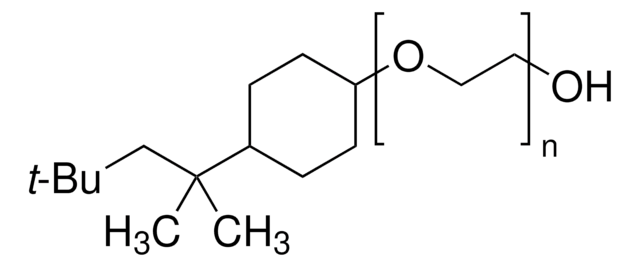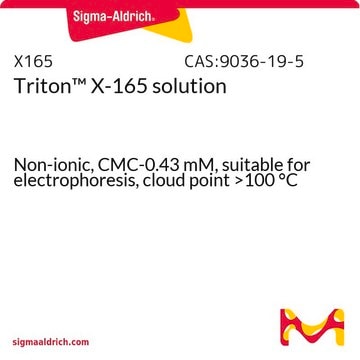X405
Triton™ X-405 solution
70% in H2O
Synonyme(s) :
4-(1,1,3,3-tétraméthylbutyl)phényl-polyéthylène glycol, solution, Éther tert-octylphénylique du polyéthylène glycol, Éther isooctylphénylique de polyoxyéthylène (40)
About This Item
Produits recommandés
Description
non-ionic
Niveau de qualité
Poids mol.
~1967.0 g/mol
Concentration
70% in H2O
Technique(s)
ELISA: suitable
CMC
0.81 mM
Température de transition
cloud point >100 °C
Densité
1.096 g/mL at 25 °C
HLB
17.6
Chaîne SMILES
CC(C)(C)CC(C)(C)c1ccc(OCCOCCOCCOCCOCCOCCOCCO)cc1
InChI
1S/C28H50O8/c1-27(2,3)24-28(4,5)25-6-8-26(9-7-25)36-23-22-35-21-20-34-19-18-33-17-16-32-15-14-31-13-12-30-11-10-29/h6-9,29H,10-24H2,1-5H3
Clé InChI
HNLXNOZHXNSSPN-UHFFFAOYSA-N
Vous recherchez des produits similaires ? Visite Guide de comparaison des produits
Catégories apparentées
Description générale
Application
- pour redisperser des nanotubes de carbone monofeuillets semiconducteurs (S-SWCNT/SWCNT) en vue d'une caractérisation spectroscopique par absorption.
- comme constituant d'une solution d'hydroxyde de sodium pour solubiliser des carcasses animales en vue d'un comptage par scintillation en milieu liquide.
- comme tensioactif dans un moussage direct pour étudier ses effets sur la viscosité de pâtes de géopolymère.
Attention
Informations légales
Mention d'avertissement
Danger
Mentions de danger
Conseils de prudence
Classification des risques
Acute Tox. 4 Oral - Aquatic Acute 1 - Aquatic Chronic 1 - Eye Dam. 1 - Skin Irrit. 2
Code de la classe de stockage
10 - Combustible liquids
Classe de danger pour l'eau (WGK)
WGK 3
Point d'éclair (°F)
Not applicable
Point d'éclair (°C)
Not applicable
Choose from one of the most recent versions:
Déjà en possession de ce produit ?
Retrouvez la documentation relative aux produits que vous avez récemment achetés dans la Bibliothèque de documents.
Notre équipe de scientifiques dispose d'une expérience dans tous les secteurs de la recherche, notamment en sciences de la vie, science des matériaux, synthèse chimique, chromatographie, analyse et dans de nombreux autres domaines..
Contacter notre Service technique






